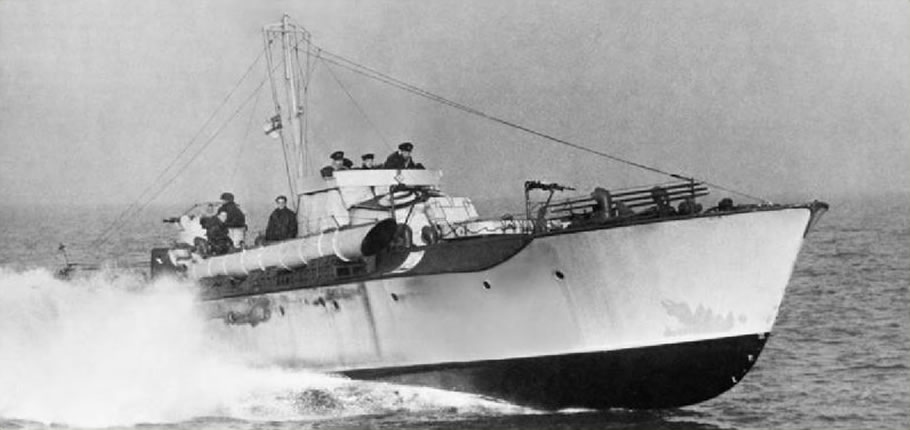
Torpedo Boats – World War 2
“A surface vessel of war whose main armament is torpedoes, and is intended to travel at sea with the battle fleet to attack major enemy warships.”
At the outbreak of war there were three flotillas of Motor Torpedo “short boats” between 60 ft. (18 m) and 72 feet (22 m) long. These could typically maintain 40 knots and were armed with two torpedo tubes. They were built mainly by the British Power Boat Company, Vosper and Thornycroft. In 1940 a modified craft, the Motor Gun Boat, was introduced. These were armed with weapons such as the 0.5 in Vickers machine gun, 2 pounder “pom pom”, a single or twin 20 mm Oerlikon and ultimately the autoloader fitted 6-pounder gun.
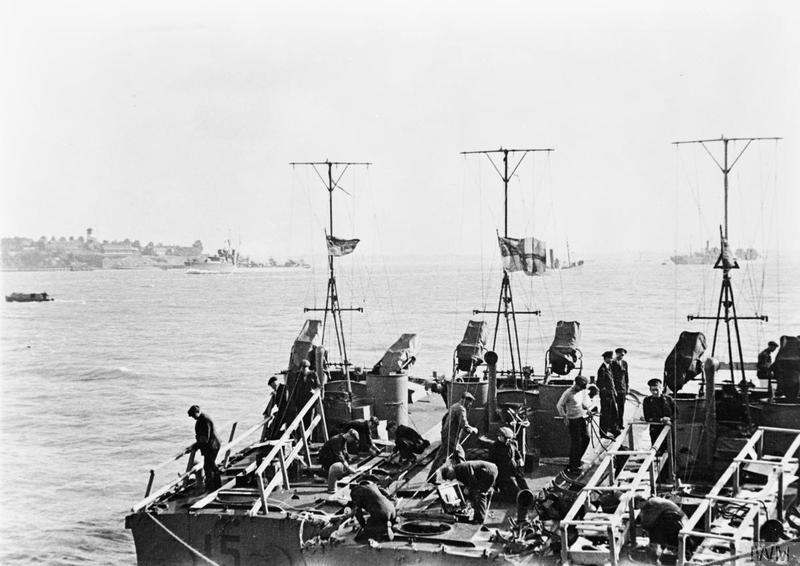
MTB’s at Harwich 1940
MTBs were designed for high speed, operating at night, low speed ambush (to keep noise low and to produce no wake) and manoeuvrability on the water; this was to enable them to get close enough to launch their torpedoes at enemy vessels. With next to no armor, the boats relied upon surprise and their agility at high speed to avoid being hit by gunfire from bigger ships.
The British Power Boat Company (BPB)
Established the first impetus to the revitalization of the speedboat designs before the Second World War, but then fell apparently back due to personal differences between decision-makers in the shipyard and the Admiralty in importance as MTB producer. However, the yard was even more involved in the production of MGB. BPB built before the war boats of 60 ft. and during the war, only those with 72 ft. lengths.
British Power Boat 60 ft.
They were based on the British Power Boat rescue craft and were originally designed for the Royal Air Force but reduced to 60 ft. (18 m) in length. They could carry two 18-inch (457 mm) torpedoes and achieve a maximum speed of 33 knots (38 mph; 61 km/h).
MTB 14
- Type. BPB 60
- Builder. British Power Boat
- Ordered. 11/01/1938
- Dimensions. Length: 60 feet, 3 inches
- Commissioned. 25/10/1938
- Propulsion. Three Napier engines.
- Complement. 9 men
- Armament. 2 18” torpedo tubes
- Speed. 33 knots
- Fate. Renamed 1942
-
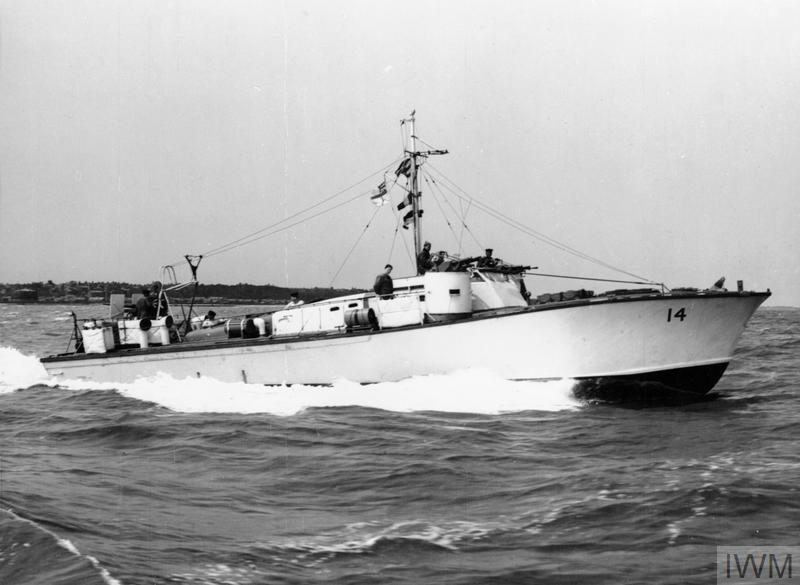
MTB14 © IWM.
MTB 14 was built by British Power Boat, Hythe and commissioned on the 25th October 1938 the 60” foot boat was armed with two 18” torpedoes. MTB 14 operated as part of the 1st Flotilla based at Lowestoft, Felixstowe and Harwich from 1940 until 1942. She was reclassified as target towing vessel CT 09 in 1942
1/42 Repairing at Harwich 7/1/42 Repairs complete.
MTB 15
- Type. BPB 60
- Builder. British Power Boat
- Ordered. 11/01/1938
- Dimensions. Length: 60 feet, 3 inches
- Propulsion. Three Napier engines.
- Commissioned. 17/12/1939
- Complement. 9 men
- Armament. 2 18″ torpedo tubes
- Speed. 33 knots
- Fate. Mined 24/09/1940
MTB 15 was built by British Power Boat, Hythe and commissioned on the 17th February 1939 the 60” foot boat was armed with two 18” torpedoes. MTB 15 operated as part of the 1st Flotilla based at Lowestoft, Felixstowe and Harwich from 1940 until 1942. she was sunk in the Thames estuary on the 24th September 1940.
MTB 17
- Type. BPB 60
- Builder. British Power Boat
- Ordered. 11/01/1938
- Dimensions. Length: 60 feet, 3 inches
- Propulsion. Three Napier engines.
- Commissioned. 13/03/1939
- Complement. 9 men
- Armament. 2 18″ torpedo tubes
- Speed. 33 knots
- Fate. Mined 21/10/1940
-

MTB17
© IWM.
MTB 17 was built by British Power Boat, Hythe and commissioned on the 13th March 1939 the 60” foot boat was armed with two 18” torpedoes. MTB 17 operated as part of the 1st Flotilla based at Lowestoft, Felixstowe and Harwich from 1940 until 1942. she was mined at Ostend, Belgium on the 21st October 1940.
MTB 18
- Type. BPB 60
- Builder. British Power Boat
- Ordered. 11/01/1938
- Dimensions. Length: 60 feet, 3 inches
- Propulsion. Three Napier engines.
- Commissioned. 24/03/1939
- Complement. 9 men
- Armament. 2 18″ torpedo tubes
- Speed. 33 knots
- Fate. Renamed 1942
MTB 18 was built by British Power Boat, Hythe and commissioned on the 24th March 1939 the 60” foot boat was armed with two 18” torpedoes. MTB 18 operated as part of the 1st Flotilla based at Lowestoft, Felixstowe and Harwich from 1940 until 1942. she was renamed CT 10 in 1942.
John I. Thornycroft & Company Limited.
Although the shipyard production in the inter-war period continued for export, they missed the boat developing new concepts and were involved in World War II only to a small extent. The company Thornycroft built during World War CMB for the Royal Navy at 40 and 55 feet (ft.), and later with MTB 72 and75 ft. in length.
Vosper 73 foot Motor Torpedo Boat.
A mid-twentieth century British military boat design by Vosper’s. at 73 ft. (22 m) long they were considered small boats compared to longer designs such as the Fairmile Type D. The design came about from a requirement that British Motor Torpedo Boats should be better able to fight small craft, which was the job of Motor Gun Boats.
MTB 24
- Type. Thornycroft 73
- Builder. Thornycroft
- Ordered. 15/08/1938
- Dimensions. Length: 73 feet
- Propulsion. Three Sterling engines.
- Commissioned. 19/12/1939
- Complement. 13 men
- Armament. 4 18″ torpedo tubes
- Speed. 43 knots
- Fate. Sold 1945
-
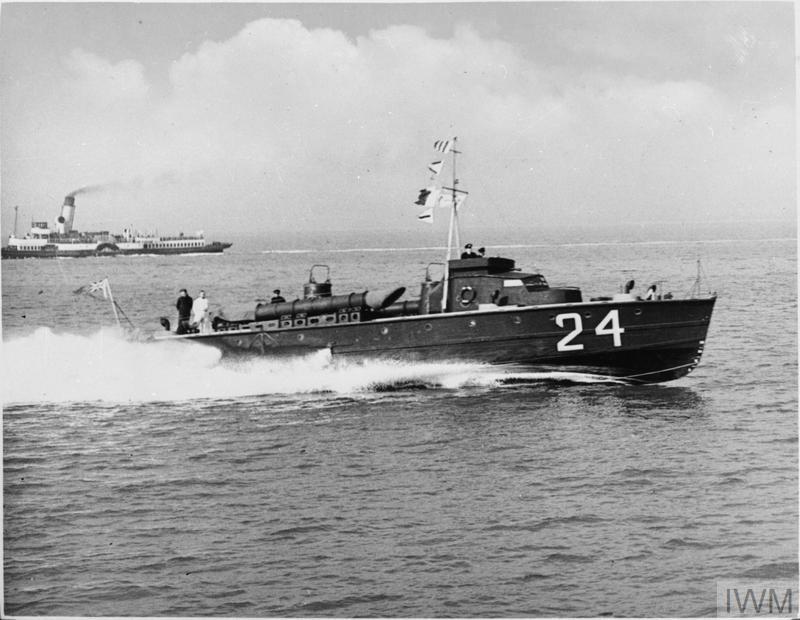
MTB24 © IWM (FL 25737)
MTB 24 was built at the Thornycroft, Hampton on Thames and delivered to the Royal Navy in December 1939. It was armed with four 18” inch torpedo tubes. MTB 24 operated as part of the 4th & 5th Flotilla based at Felixstowe, Gosport, and Harwich from 1940 until 1942. MTB 24 was sold in October 1945.
MTB 25
- Type. Thornycroft 73
- Builder. Thornycroft
- Ordered. 15/08/1938
- Dimensions. Length: 73 feet
- Propulsion. Three Sterling engines.
- Commissioned. 22/01/1940
- Complement. 13 men
- Armament. 4 18″ torpedo tubes
- Speed. 40 knots
- Fate. Sold 1945
MTB 25 was built at the Thornycroft, Hampton on Thames and delivered to the Royal Navy in January 1940. It was armed with four 18” inch torpedo tubes. MTB 25 operated as part of the 4th Flotilla based at Felixstowe, Dover, and Harwich from 1940 until 1942. MTB 25 was sold in October 1945.
MTB 28
- Type. Thornycroft 73
- Builder. Thornycroft
- Ordered. 08/09/1938
- Dimensions. Length: 73 feet
- Propulsion. Three Sterling engines.
- Commissioned. 10/07/1940
- Complement. 13 men
- Armament. 4 18″ torpedo tubes
- Speed. 40 knots
- Fate. Scrapped 1943
-
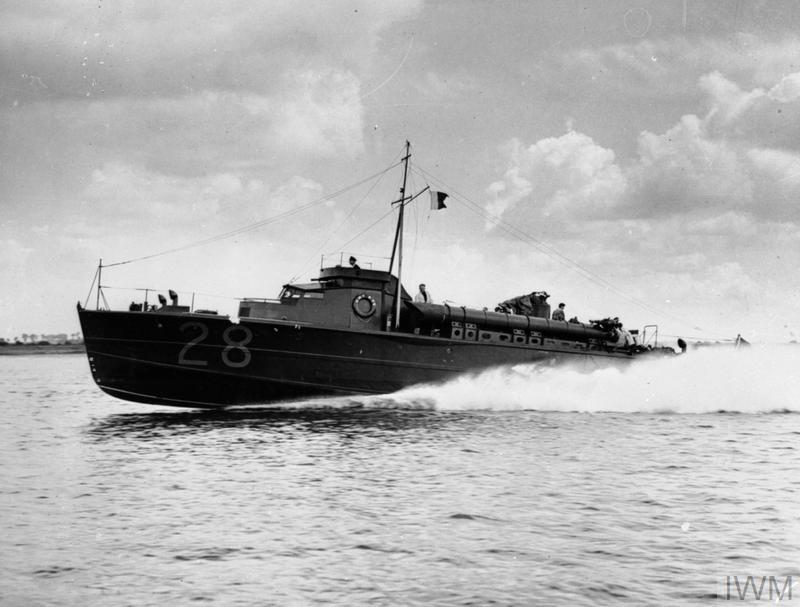
MTB28 © IWM (FL 25666)
MTB 28 was built at the Thornycroft, Hampton on Thames and delivered to the Royal Navy in July 1940. It was armed with four 18” inch torpedo tubes. MTB 28 operated as part of the 4th Flotilla based at Felixstowe, Dover, and Harwich from 1940 until 1942. MTB 28 was burned out near Portsmouth on the 7th March 1941,declared a total loss 5 and was classified as target towing vessel CT 22 in 1943.
Experimental Motor Torpedo Boat.
The “Experimental boats were produced from 1940 and were designed to be carried as an attack launch by larger warships. Based on the pre-war design these experimental craft were deemed to small for operational use.
MTB 100
- Type. BPB Experimental
- Builder. British Power Boat
- Ordered. 04/03/1937
- Commissioned. 28/04/1938
- Complement.
- Armament.
- Speed. Knots
- Fate.
-
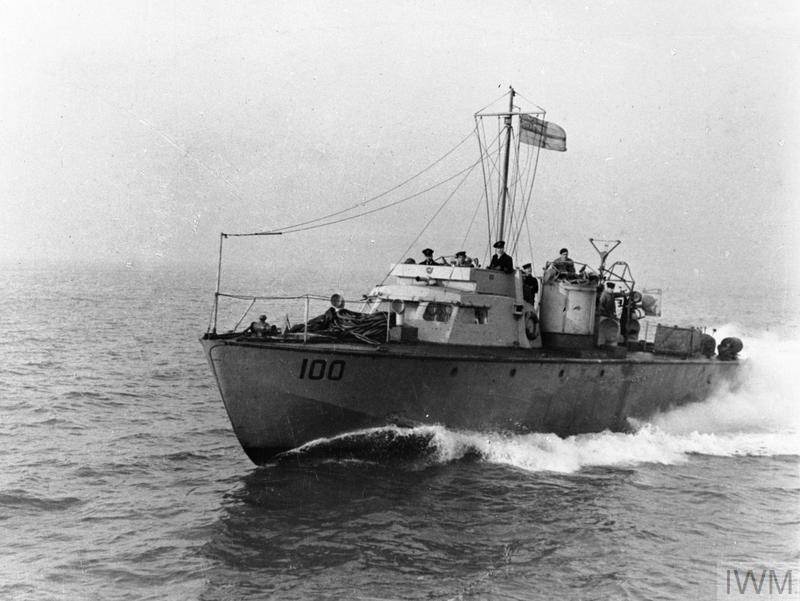
MTB 100
© IWM.
MTB 100 was built by British Power Boat, Hythe and commissioned on the 28th April March 1938. MTB 100 operated as part of the 1st Flotilla based at Lowestoft, Felixstowe and Harwich from 1940 until 1942. She was renamed CT 10 in 1943.
1/42 Repairing at Harwich 7/1/42 Repairs complete.
MTB 104
- Type. Experimental 104/105
- Builder. Thornycroft
- Ordered. 09/01/1940
- Completed. 1940
- Commissioned. 09/01/1940
- Speed. 43 knots
- Fate. End service 1941
-
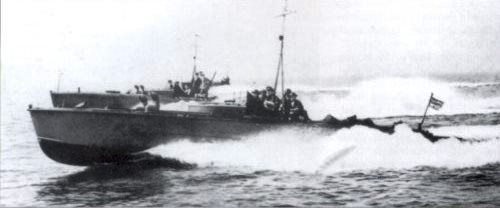
MTB104
MTB 104 was one of four 45-foot craft built during 1940 at the Thornycroft Yard at Hampton on Thames and delivered to the Royal Navy in 1940. MTB 104 operated as part of the 10th Flotilla based at Felixstowe and Harwich from 1940 until 1941.
MTB 106
- Type. Experimental 106/107
- Builder. Thornycroft
- Ordered. 06/04/1939
- Completed. 1940
- Commissioned. 06/04/1939
- Speed. 43 knots
- Fate. Sank 16/10/1940
MTB 106 was one of four 45-foot craft built during 1940 at the Thornycroft Yard at Hampton on Thames and delivered to the Royal Navy in 1940. MTB 106 operated as part of the 10th Flotilla based at Felixstowe and Harwich from 1940 until 1941.
Vosper & Company
Vosper was the last of the three companies in the race for orders, but was the main supplier of motor torpedo boats and finally delivered over two-thirds of all boats. After World War II Vosper remained the only supplier. In 1966, the merger with Thornycroft, but was pursued at a time when the MTB concept any more. The boatbuilding premises of this firm, long famed for brilliant design and superb craftsmanship in yacht building, stand on the Gosport side of Portsmouth Harbour and at Northam on Southampton Water.
Vosper 70 foot Motor Torpedo Boat
Although various boat lengths were produced by Vosper for the Royal Navy, the “70 ft.” boat was produced from 1940. Using three Packard marine engines, they were capable of around 37 kn (43 mph; 69 km/h). Early models carried two 21-inch (533 mm) torpedo tubes, two 0.50 in (13 mm) machine guns and two 0.303 in (7.7 mm) machine guns. depth charges.
MTB 22
- Type. Vosper 70
- Builder. Vosper
- Dimensions. Length: 70 feet
- Completed. 09/06/1939
- Commissioned. 1939
- Armament. 2 21″ torpedo tubes
- Complement. 10 men
- Speed. 25 knots
- Fate. Sold 1945
-
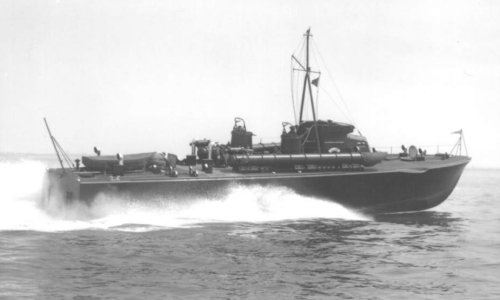
Motor Torpedo Boat
MTB 22 was built by Vosper, Porchester and commissioned in 1939 the 70” foot boat was armed with two 21” torpedoes. MTB 22 operated as part of the 4th Flotilla based at Felixstowe, Gosport and Harwich from 1940 until 1943. she was sold in 1945.
MTB 29
- Type. Vosper 70
- Builder. Camper & Nicholson
- Dimensions. Length: 70 feet
- Completed. 02/06/1940
- Commissioned. 1940
- Armament. 2 21″ torpedo tubes
- Complement. 10 men
- Speed. 25 knots
- Fate. Sank 06/10/1942
MTB 29 was built by Camper & Nicholson at their Gosport yard and delivered to the Royal Navy in June 1939, the 70” foot boat was armed with two 21” torpedoes. MTB 29 operated as part of the 4th Flotilla based at Felixstowe and Harwich from 1940 until 1942. She was sunk in a collision with a German MTB in the North Sea on the 6th October 1942.
MTB 30
- Type. Vosper 70
- Builder. Camper & Nicholson
- Dimensions. Length: 70 feet
- Completed. 10/07/1940
- Commissioned. 11/07/1940
- Armament. 2 21″ torpedo tubes
- Complement. 10 men
- Speed. 25 knots
- Fate. Mined 18/12/1942
-
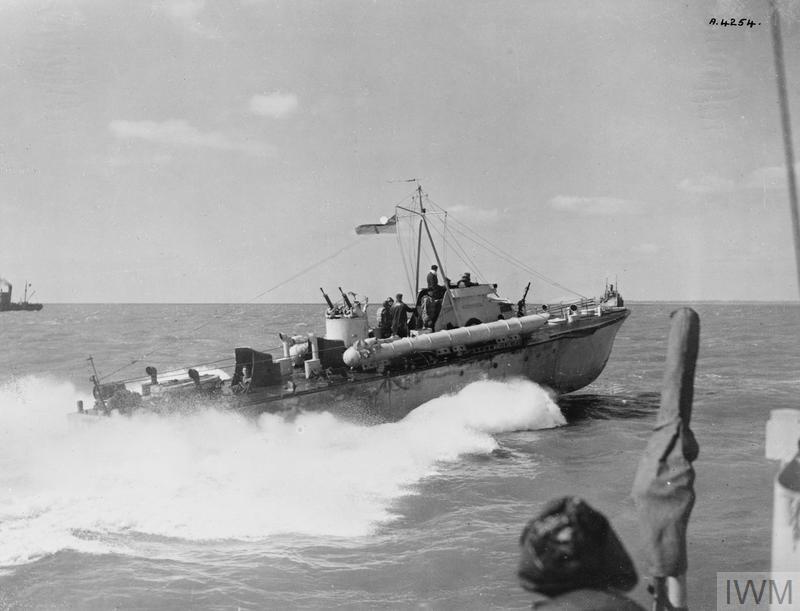
MTB30 © IWM (A 4254)
MTB 30 was one of three 70-foot Vosper boats ordered in September 1938, MTB 30 was built at the Camper & Nicholson Yard at Gosport and delivered to the Royal Navy in June 1939. It was armed with two 21-inch torpedo tubes and a twin 5-inch Vickers machine gun in a turret behind the bridge. MTB 30 operated as part of the 4th Flotilla based at Felixstowe and Harwich from 1940 until 1942. Powered by three 1,200hp engines it could attain speeds of up to 42 knots. MTB 30 was lost after striking a mine in the North Sea on December 18th 1942.
MTB 31
- Type. Vosper 70
- Builder. Vosper
- Dimensions. Length: 70 feet
- Completed. 05/07/1940
- Commissioned. 05/07/1940
- Armament. 2 21″ torpedo tubes
- Complement. 10 men
- Speed. 25 knots
- Fate. Renamed 1943
MTB 31 was built at the Vosper yard in Porchester and delivered to the Royal Navy in June 1939. It was armed with two 21-inch torpedo tubes and a twin 5-inch Vickers machine gun in a turret behind the bridge. MTB 31 operated as part of the 4th Flotilla based at Felixstowe and Harwich from 1940 until 1942 Powered by three 1,200hp engines it could attain speeds of up to 42 knots. MTB 31 was converted into a towing target in 1943.
MTB 32
- Type. Vosper 70
- Builder. Vosper
- Dimensions. Length: 70 feet
- Completed. 24/07/1940
- Commissioned. 24/07/1940
- Armament. 2 21″ torpedo tubes
- Complement. 10 men
- Speed. 25 knots
- Fate. Renamed 1943
-
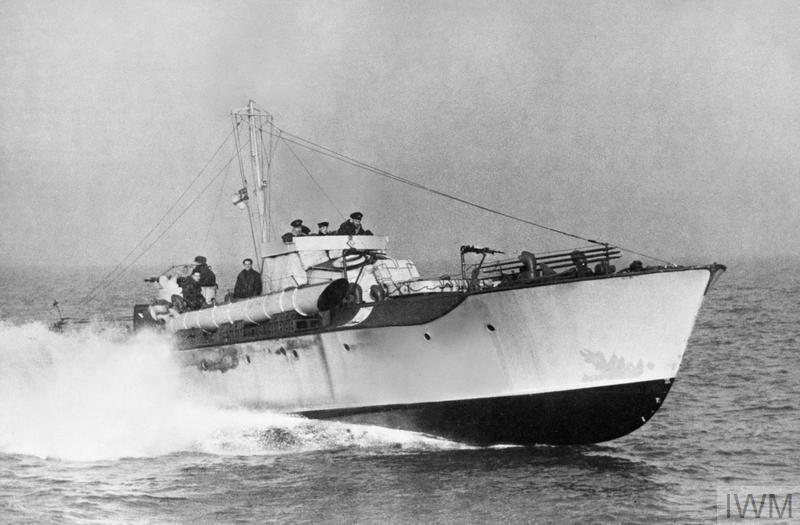
MTB32 © IWM (D 12524)
MTB 32 was built at the Vosper Porchester yard and delivered to the Royal Navy in June 1939. It was armed with two 21-inch torpedo tubes and a twin 5-inch Vickers machine gun in a turret behind the bridge. MTB 32 operated as part of the 4th Flotilla based at Felixstowe and Harwich from 1940 until 1942, powered by three 1,200hp engines it could attain speeds of up to 42 knots. MTB 32 was converted into a towing target in 1943.
MTB 34
- Type. Vosper 70
- Builder. Vosper
- Dimensions. Length: 70 feet
- Completed. 13/08/1940
- Commissioned. 13/08/1940
- Armament. 2 21″ torpedo tubes
- Complement. 10 men
- Speed. 25 knots
- Fate. Renamed 1943
-
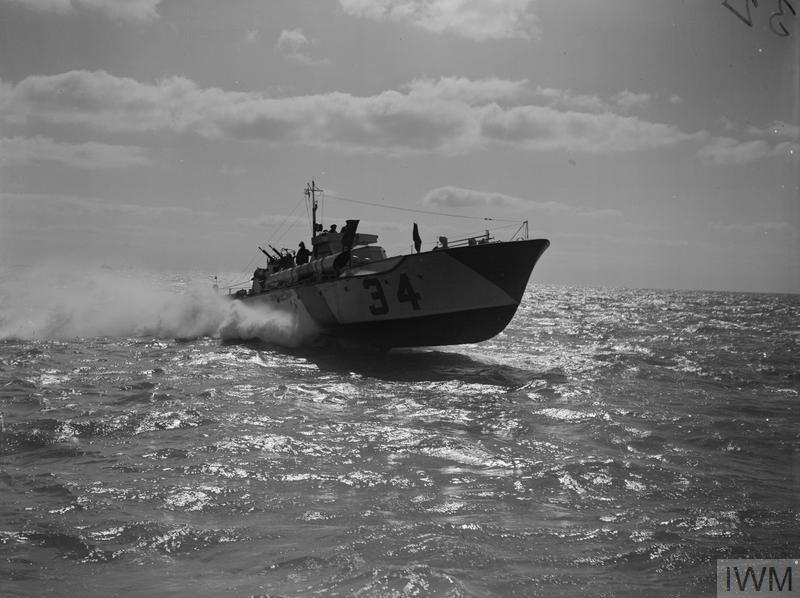
MTB34 © IWM (A 4245)
MTB 34 was built at the Vosper Porchester yard and delivered to the Royal Navy in June 1939. It was armed with two 21-inch torpedo tubes and a twin 5-inch Vickers machine gun in a turret behind the bridge. MTB 34 operated as part of the 4th Flotilla based at Felixstowe and Harwich from 1940 until 1942 Powered by three 1,200hp engines it could attain speeds of up to 42 knots. MTB 34 was converted into a towing target in 1943.
Vosper 60 foot Motor Torpedo Boat
Although various boat lengths were produced by Vosper for the Royal Navy, the “60 ft.” boat was produced from 1940, they were capable of around 35 knots and had a complement of 10 men.
MTB 71
- Type. Vosper 60
- Builder. Vosper
- Dimensions. Length: 60 feet
- Completed. 1940
- Commissioned. 02/07/1940
- Complement. 10 men
- Armament. 2 18” torpedo tubes
- Speed. 32 knots
- Fate. Sold 1943
MTB 71 was built at Vosper, Portsmouth and delivered to the Royal Navy in 1940. It was armed with two 18” inch torpedo tubes. MTB 71 operated as part of the 1sth Flotilla based at Felixstowe and Harwich from 1940 until 1943. MTB 71 was taken over by the Royal Navy in May 1940 and the Royal Army Service Corps in 1943.
January 1942 Repairing at Harwich.
MTB 72
- Type. Vosper 60
- Builder. Vosper
- Dimensions. Length: 70 feet
- Completed. 06/07/1940
- Commissioned. 06/07/1940
- Armament. 2 18″ torpedo tubes
- Complement. 10 men
- Speed. 35 knots
- Fate. Sold 1946
MTB 72 was built at Vosper, Portsmouth and delivered to the Royal Navy in 1940. It was armed with two 18” inch torpedo tubes. MTB 72 operated as part of the 4th Flotilla based at Felixstowe and Harwich from 1940 until 1943. MTB 728 was taken over by the RASC and eventually sold in 1946.
Vosper 72 foot Motor Torpedo Boat
The boats carried two 21-inch torpedo tubes as their major offensive armament and a top speed of 39 knots.
MTB 93
- Type. Vosper 72
- Builder. Berthon Boat Yard
- Ordered. 20/05/1940
- Completed. 10/09/1942
- Commissioned. 10/09/1942
- Armament. 2 21″ torpedo tubes
- Complement. 13 men
- Speed. 39 knots
- Fate. Sank 18/08/1944
MTB 93 was built at the Berthon Boat Yard in Lymington and delivered to the Royal Navy in 1942. It was armed with two 21” inch torpedo tubes. MTB 93 operated as part of the 4th Flotilla based at Harwich from 1942 until 1944. MTB 93 was foundered off Harwich on the 18th August 1944 after colliding with MTB 729.
MTB 223
- Type. Vosper 72
- Builder. Vosper
- Ordered. 22/02/1941
- Completed. 1942
- Commissioned. 09/04/1942
- Armament. 2 21″ torpedo tubes
- Complement. 13 men
- Speed. 39 knots
- Fate. Sold 1945
MTB 223 was ordered from Vosper, Portsmouth in February 1941, laid down four months later and entered service in April 1942, It was one of 48 Vosper 72-foot 6-inch boats ordered during 1941. MTB 223 operated as part of the 21st MTB Flotilla based at Lowestoft, Felixstowe and Harwich from 1942 until 1944.
MTB 224
- Type. Vosper 72
- Builder. Vosper
- Ordered. 22/02/1941
- Completed. 12/05/1942
- Commissioned. 12/05/1942
- Armament. 2 21″ torpedo tubes
- Complement. 13 men
- Speed. 39 knots
- Fate. Sold 1946
-
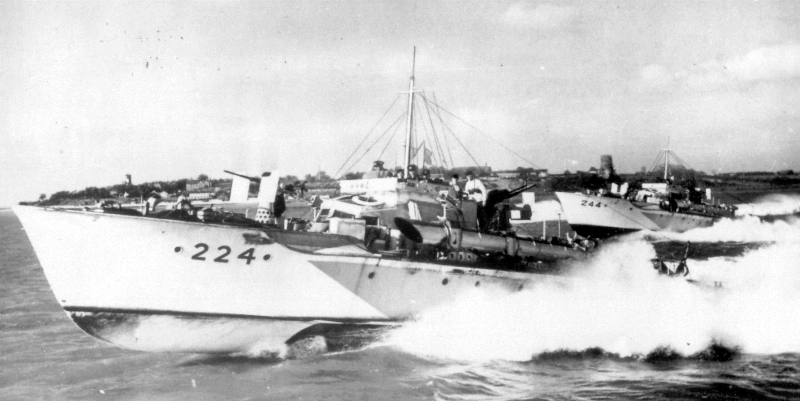
MTB224
MTB 224 was ordered from Vosper, Portsmouth in February 1941 and entered service in April 1942, it was one of 48 Vosper 72-foot 6-inch boats ordered during 1941. MTB 224 operated as part of the 21st MTB Flotilla based at Lowestoft, Felixstowe and Harwich from 1942 until 1944.
MTB 225
- Type. Vosper 72
- Builder. Vosper
- Ordered. 22/02/1941
- Completed. 12/06/1942
- Commissioned. 12/06/1942
- Armament. 2 21″ torpedo tubes
- Complement. 13 men
- Speed. 39 knots
- Fate. Sold 1945
MTB 225 was ordered from Vosper, Portsmouth in February 1941 and entered service in May 1942, it was one of 48 Vosper 72-foot 6-inch boats ordered during 1941. MTB 225 operated as part of the 21st MTB Flotilla based at Lowestoft, Felixstowe and Harwich from 1942 until 1944.
MTB 232
- Type. Vosper 72
- Builder. Berthon Boat Yard
- Ordered. 22/02/1941
- Completed. 02/04/1942
- Commissioned. 02/04/1942
- Armament. 2 21″ torpedo tubes
- Complement. 13 men
- Speed. 39 knots
- Fate. Sold 1944
-
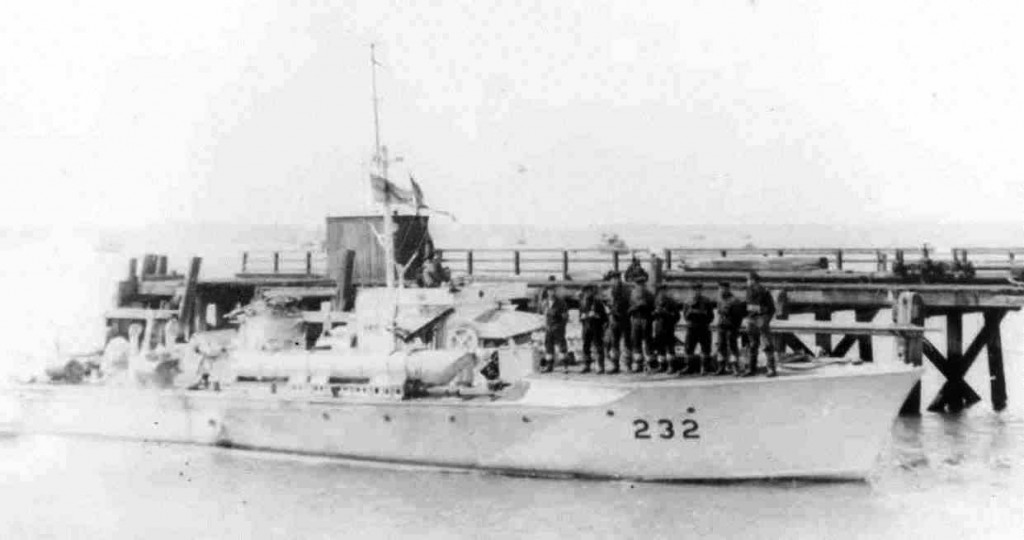
MTB232
MTB 232 entered service in April 1942; it was one of 48 Vosper 72-foot 6-inch boats ordered during 1941. MTB 232 operated as part of the 21st MTB Flotilla based at Lowestoft, Felixstowe and Harwich from 1942 until 1944.
MTB 233
- Type. Vosper 72
- Builder. Berthon Boat Yard
- Ordered. 22/02/1941
- Completed. 12/01/1942
- Commissioned. 12/01/1942
- Armament. 2 21″ torpedo tubes
- Complement. 13 men
- Speed. 39 knots
- Fate. Sold 1945
MTB 233 was built at Berthon Boat Yard and entered service in 1942, it was one of 48 Vosper 72-foot 6-inch boats ordered during 1941. MTB 233 operated as part of the 21st Flotilla based at Lowestoft, Felixstowe and Harwich from 1942 until 1944.
MTB 234
- Type. Vosper 72
- Builder. Berthon Boat Yard
- Ordered. 22/02/1941
- Completed. 12/04/1942
- Commissioned. 12/04/1942
- Armament. 2 21″ torpedo tubes
- Complement. 13 men
- Speed. 39 knots
- Fate. Sold 1945
-
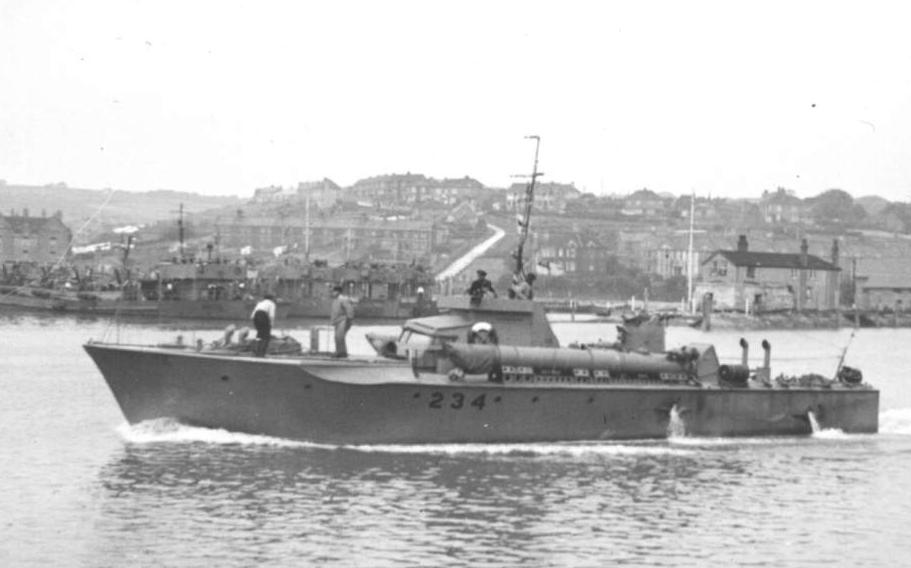
MTB234
MTB 234 was built at Berthon Boat Yard and entered service in 1942, it was one of 48 Vosper 72-foot 6-inch boats ordered during 1941. MTB 234 operated as part of the 21st MTB Flotilla based at Lowestoft, Felixstowe and Harwich from 1942 until 1944.
MTB 237
- Type. Vosper 72
- Builder. Camper & Nicholson
- Ordered. 22/02/1941
- Completed. 18/06/1942
- Commissioned. 18/06/1942
- Armament. 2 21″ torpedo tubes
- Complement. 13 men
- Speed. 39 knots
- Fate. Sank 07/08/1942
MTB 237 was built by Camper & Nicholson and entered service in April 1942, it was one of 48 Vosper 72-foot 6-inch boats ordered during 1941. MTB 237 operated as part of the 21st MTB Flotilla based at Lowestoft, Felixstowe and Harwich from 1942 until 1944. MTB 237 was sunk by gunfire from German surface forces off Barfleur, France on 7 August 1942.
MTB 241
- Type. Vosper 72
- Builder. Morgan Giles
- Ordered. 22/02/1941
- Completed. 30/03/1942
- Commissioned. 30/03/1942
- Armament. 2 21″ torpedo tubes
- Complement. 13 men
- Speed. 39 knots
- Fate. Sank 31/03/1944
MTB 241 was built by Morgan Giles, Teignmouth and entered service in 1942, it was one of 48 Vosper 72-foot 6-inch boats ordered during 1941. MTB 241 operated as part of the 21st MTB Flotilla based at Lowestoft, Felixstowe and Harwich from 1942 until 1944. MTB 241 was Sunk by gunfire from German surface forces off Ijmuiden, Netherlands on 31 March 1944.
MTB 244
- Type. Vosper 72
- Builder. Vosper
- Ordered. 02/12/1940
- Completed. 12/12/1942
- Commissioned. 12/12/1942
- Armament. 2 21″ torpedo tubes
- Complement. 13 men
- Speed. 39 knots
- Fate. Sold 1944
-
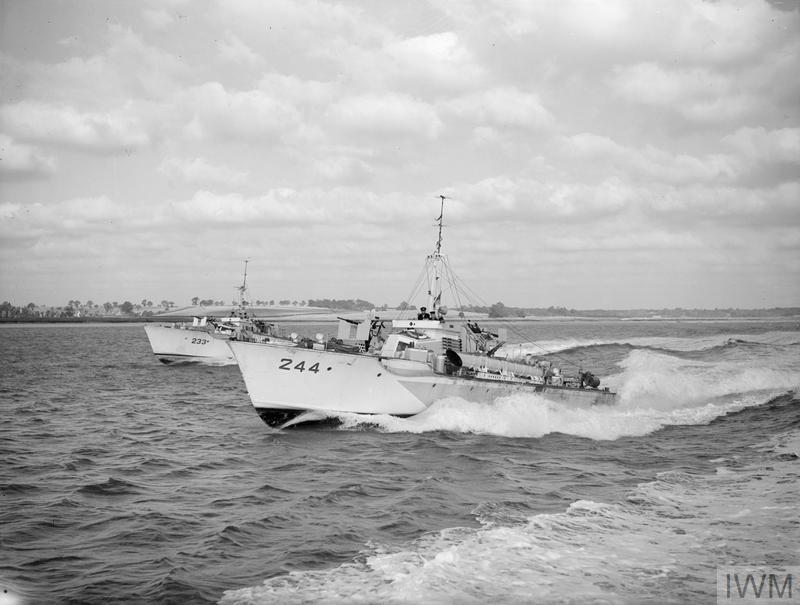
MTB244 © IWM (A 25856)
MTB 244 was built by Vosper, Portsmouth and entered service in December 1942, it was one of 48 Vosper 72-foot 6-inch boats ordered during 1940. MTB 244 operated as part of the 21st MTB Flotilla based at Lowestoft, Felixstowe and Harwich from 1942 until 1944.
Vosper 73 foot Motor Torpedo Boat.
At 73 ft. (22 m) long they were considered small boats compared to longer designs such as the Fairmile Type D. The design came about from a requirement that British Motor Torpedo Boats should be better able to fight small craft, which was the job of Motor Gun Boats.
The boats carried four 18-inch torpedo tubes as their major offensive armament along with Oerlikon 20 mm cannon and some defensive armament (Vickers K machine guns) for protection against enemy aircraft. The Type II gave up two torpedo tubes, but gained a 6-pounder gun which displaced the twin Oerlikon to the aft deck. This made it more capable of performing the Motor Gun Boat role.
MTB 385
- Type. Vosper 73
- Builder. Vosper
- Ordered. 10/03/1943
- Completed. 05/10/1944
- Commissioned. 05/10/944
- Armament. 4 18″ torpedo tubes
- Complement. 13 men
- Speed. 39 knots
- Fate. Sold 1946
-

MTB385 © IWM (FL 25739)
MTB 385 was ordered from Vosper, Porchester in March 1943, it was one of 15 Vosper 73-foot Type 1 boats ordered during 1943. MTB 385 operated as part of the 21st MTB Flotilla based at Lowestoft, Felixstowe and Harwich from 1943 until 1945.
MTB 387
- Type. Vosper 73
- Builder. Vosper
- Ordered. 10/03/1943
- Completed. 21/11/1944
- Commissioned. 21/11/1944
- Armament. 4 18″ torpedo tubes
- Complement. 13 men
- Speed. 39 knots
- Fate. Sold 25/10/1945
MTB 387 was ordered from Vosper, Porchester in March 1943, it was one of 15 Vosper 73-foot Type I boats ordered during 1943. MTB 387 operated as part of the 21st MTB Flotilla based at Lowestoft, Felixstowe and Harwich from 1943 until 1945.
MTB 388
- Type. Vosper 73
- Builder. Vosper
- Ordered. 10/03/1943
- Completed. 09/01/1945
- Commissioned. 09/01/1945
- Armament. 4 18″ torpedo tubes
- Complement. 13 men
- Speed. 39 knots
- Fate. Sold 1945
MTB 388 was ordered from Vosper, Porchester in March 1943, it was one of 15 Vosper 73-foot Type I boats ordered during 1943. MTB 388 operated as part of the 21st MTB Flotilla based at Lowestoft, Felixstowe and Harwich from 1943 until 1945.
MTB 389
- Type. Vosper 73
- Builder. Vosper
- Ordered. 10/03/1943
- Completed. 01/02/1945
- Commissioned. 01/02/1945
- Armament. 4 18″ torpedo tubes
- Complement. 13 men
- Speed. 39 knots
- Fate. Sold 04/06/1948
MTB 389 was ordered from Vosper, Porchester in March 1943, it was one of 15 Vosper 73-foot Type I boats ordered during 1943. MTB 389 operated as part of the 21st MTB Flotilla based at Lowestoft, Felixstowe and Harwich from 1945 until 1948.
MTB 390
- Type. Vosper 73
- Builder. Vosper
- Ordered. 10/03/1943
- Completed. 04/08/1944
- Commissioned. 04/08/1944
- Armament. 4 18″ torpedo tubes
- Complement. 13 men
- Speed. 39 knots
- Fate. Sold 1945
MTB 390 was ordered from Vosper, Wivenhoe in March 1943, it was one of 15 Vosper 73-foot Type I boats ordered during 1943. MTB 390 operated as part of the 21st MTB Flotilla based at Lowestoft, Felixstowe and Harwich from 1944 until 1945.
MTB 393
- Type. Vosper 73
- Builder. Vosper
- Ordered. 10/03/1943
- Completed. 22/12/1944
- Commissioned. 1944
- Armament. 4 18″ torpedo tubes
- Complement. 13 men
- Speed. 39 knots
- Fate. Sold 28/1/1948
-
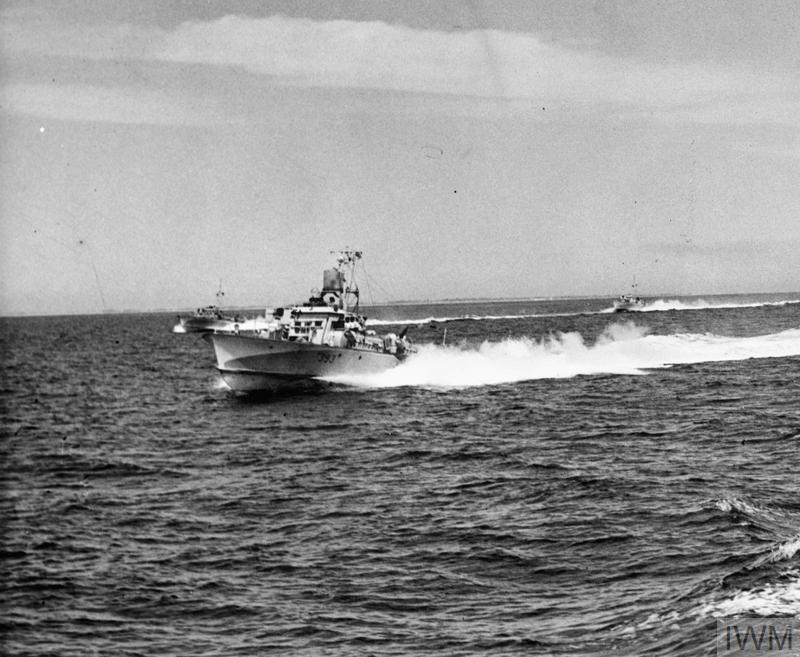
MTB393 © IWM (FL 25740)
MTB 393 was ordered from Vosper, Wivenhoe in March 1943, it was one of 15 Vosper 73-foot Type I boats ordered during 1943. MTB 393 operated as part of the 21st MTB Flotilla based at Lowestoft, Felixstowe and Harwich from 1944 until 1945.
MTB 394
- Type. Vosper 73
- Builder. Vosper
- Ordered. 10/03/1943
- Completed. 02/06/1945
- Commissioned. 1945
- Armament. 4 18″ torpedo tubes
- Complement. 13 men
- Speed. 39 knots
- Fate. Sold 1948
MTB 394 was ordered from Vosper, Wivenhoe, it was one of 15 Vosper 73-foot Type I boats ordered during 1943. MTB 394 operated as part of the 21st MTB Flotilla based at Lowestoft, Felixstowe and Harwich from 1945 until 1948.
MTB 395
- Type. Vosper 73
- Builder. Vosper
- Ordered. 10/03/1943
- Completed. 21/04/1945
- Commissioned. 1945
- Armament. 4 18″ torpedo tubes
- Complement. 13 men
- Speed. 39 knots
- Fate. Sold 4/08/1948
MTB 395 was ordered from Vosper, Wivenhoe in March 1943, it was one of 15 Vosper 73-foot Type I boats ordered during 1943. MTB 395 operated as part of the 21st MTB Flotilla based at Lowestoft, Felixstowe and Harwich from 1945 until 1948.
We are adding more information to this site on a regular basis, if you wish to submit any photos or provide any information on naval vessels that were based or visited Harwich, then please use the contact page at the bottom of the screen.
Copyright Ownership.
We attempted to get the consent of copyright holders to use this material for nearly all of the photographs on the website.
In the few cases where names are available, a thorough search was made using telephone directories, photographic copyright directories, People Search and Google Area Search. None of the copyright owners could be traced in this way and we believe we have exhausted all reasonable avenues.
The consensus opinion of these authorities was that if any two of the following situations applied we would be deemed to have taken sufficient action to avoid infringing copyright laws:
- Reasonable efforts made to contact the copyright holder
- No financial gain will be made in relation to the photos
- A letter is obtained from present owner of photos
- There is a proviso included stating that if offence is caused document will be removed
The website owner undertakes to remove any photograph from the website where offence is caused. All the above conditions have therefore been met.
← Trawlers – World War 2 Sloops, Patrol Vessels & Tugs – World War 2 →
